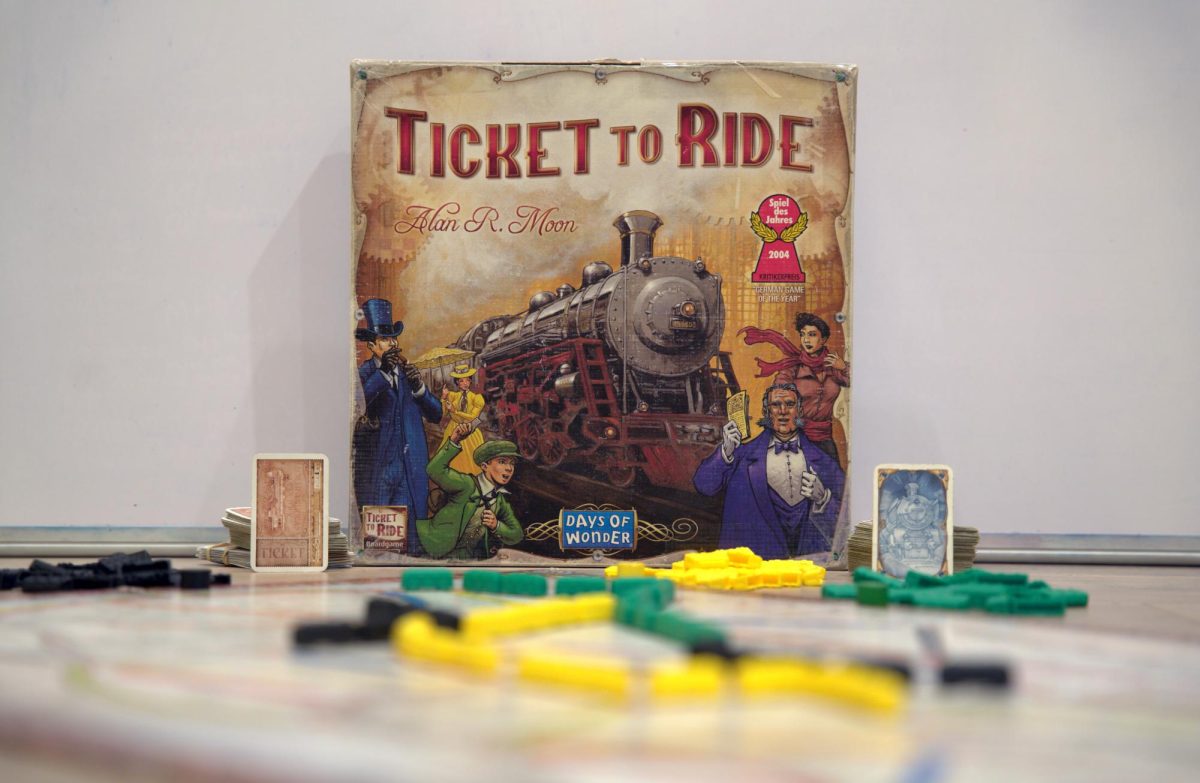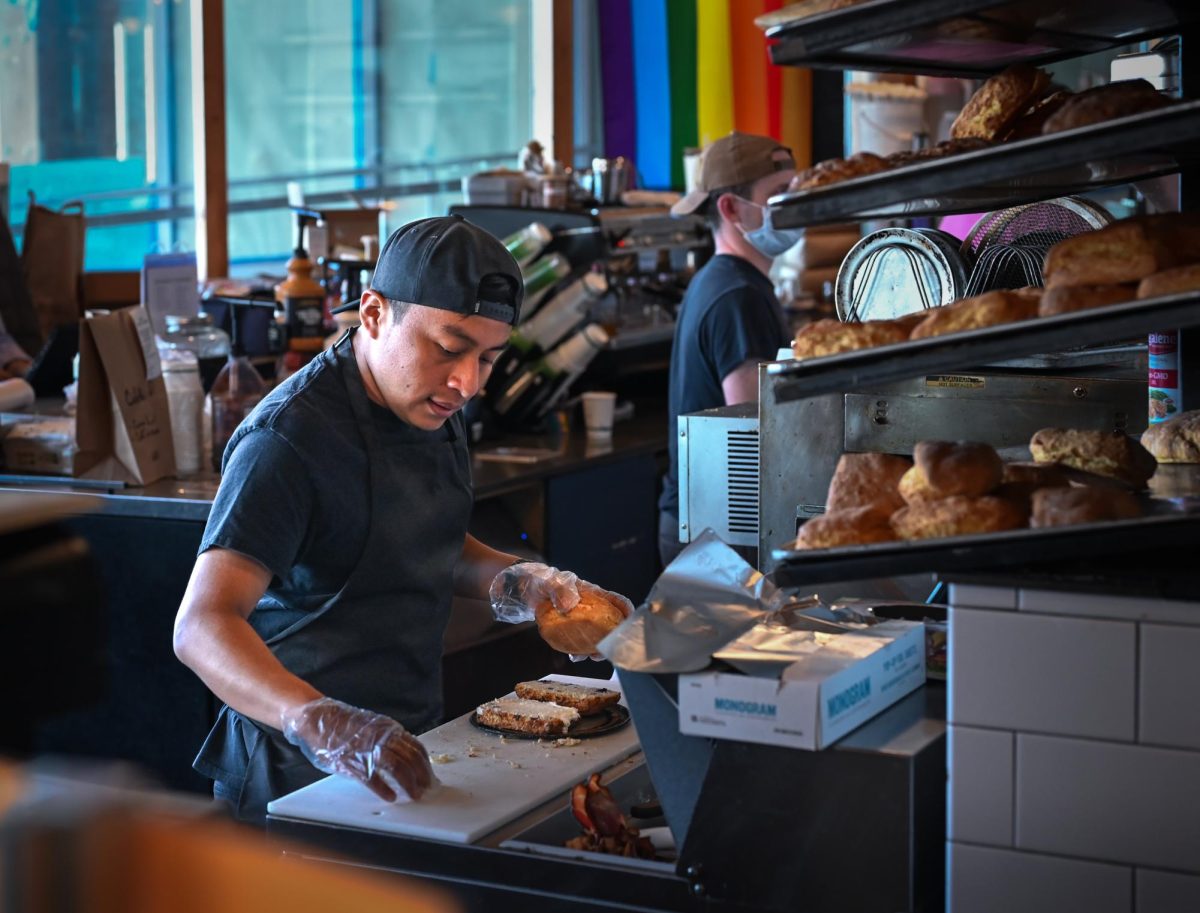As my opponent places down trains on the map, I begin to calculate alternate routes to complete my tickets, finding that the shortest path will still take many turns. However, I try to keep a straight face, knowing if my opponent realizes he has blocked me, he will have many more opportunities to continue cutting me off. Then, I notice what city he is heading towards and quickly place down trains to block him off from completing his tickets. These situations happen quite frequently when playing Ticket to Ride.
Ticket to Ride is a 30-minute board game for two to five players, with each player placing their trains on a central board of the United States to earn the most points. The game ends when one player has at most two trains left out of their initial 45. All players start with four train cards and three tickets, of which they must keep two, discarding the others. Each turn, players choose to either take two train cards, use train cards to place trains on the board or pick tickets, which score players points if the player connects the two cities shown, but deduct points if uncompleted.
To create unpredictability, ticket cards remain a secret until the game finishes, which means that no player knows whether they are ahead or behind. Since players decide when the game ends by not placing trains, they must strategically time the game’s conclusion to match when they are winning. I have lost many times after ending the game when I thought I was winning, which can create enjoyable moments when scoring points.
When first playing the game, it may seem simple. Most players try to complete their routes and pick more tickets once completing their starting tickets. However, more strategies become apparent after the first set of plays.
Players can choose to pick more tickets before completing their starting tickets. Although risky, as they must keep at least one of the three tickets drawn, it allows players to efficiently place their trains. While playing with my family, I have often seen my dad pick additional tickets on the game’s first turn, which generally puts him either far ahead or behind, depending on his draws. In some extreme cases, he has ended games with negative points, leading to hilarious discussions after the game.
Players can delay or ruin other players’ plans altogether by placing down the route they think their opponent may use. After my first few games, my dad often tried to block me off from connecting my trains, causing me to lose many points on tickets I thought I would complete. Once I learned the tickets myself, I used this strategy against my dad. This tactic can occasionally cause both of us to have very few points at the end of the game because in these games we often complete less than half of our tickets.
There are some flaws with Ticket to Ride. Because of the low number of tickets available, players may find patterns of places on the board where more tickets commonly go, causing them to pick the same strategies even when given different tickets at the beginning.
For example, since the tickets are worth more when the cities are further apart, going from the west to the east coast is much more viable than placing trains north to south. Even when dealt more tickets that go from north to south initially, the optimal play is often to go from west to east, hoping to get more tickets later in the game that match the cities the player has already connected. With my hundreds of games played, I have not found this to be too much of an issue, as the game’s replayability stems more from player interactions than choosing different tickets, but I have found it frustrating that there are many suboptimal tickets.
Both the train and ticket cards are small, which makes them much more difficult to shuffle compared to larger cards. This can become especially annoying when playing games at higher player counts, where it may be necessary to reshuffle the 110 small train cards multiple times during a game.
Finally, while the game does have some player interaction, it is quite limited overall. Although blocking off opponents is an important concept in the game, it often only happens once or twice a game, leading players to focus on their own tickets and leaving opponents to complete theirs.
Even with my hundreds of games, and knowing every ticket in the game, my opponent and I have absolutely no interaction in some games. This happens most often while playing with only two players. If players choose completely different parts of the map for their routes, they will likely have extremely minimal interaction.
While Ticket to Ride is not the most complex board game, it’s a perfect addition for anyone new to the genre who wants to figure out whether they want to dive deeper into the large world of board games.
Saahil’s rating: 4/5 Eagles


















![“[Building nerf blasters] became this outlet of creativity for me that hasn't been matched by anything else. The process [of] making a build complete to your desire is such a painstakingly difficult process, but I've had to learn from [the skills needed from] soldering to proper painting. There's so many different options for everything, if you think about it, it exists. The best part is [that] if it doesn't exist, you can build it yourself," Ishaan Parate said.](https://harkeraquila.com/wp-content/uploads/2022/08/DSC_8149-900x604.jpg)




![“When I came into high school, I was ready to be a follower. But DECA was a game changer for me. It helped me overcome my fear of public speaking, and it's played such a major role in who I've become today. To be able to successfully lead a chapter of 150 students, an officer team and be one of the upperclassmen I once really admired is something I'm [really] proud of,” Anvitha Tummala ('21) said.](https://harkeraquila.com/wp-content/uploads/2021/07/Screen-Shot-2021-07-25-at-9.50.05-AM-900x594.png)







![“I think getting up in the morning and having a sense of purpose [is exciting]. I think without a certain amount of drive, life is kind of obsolete and mundane, and I think having that every single day is what makes each day unique and kind of makes life exciting,” Neymika Jain (12) said.](https://harkeraquila.com/wp-content/uploads/2017/06/Screen-Shot-2017-06-03-at-4.54.16-PM.png)








![“My slogan is ‘slow feet, don’t eat, and I’m hungry.’ You need to run fast to get where you are–you aren't going to get those championships if you aren't fast,” Angel Cervantes (12) said. “I want to do well in school on my tests and in track and win championships for my team. I live by that, [and] I can do that anywhere: in the classroom or on the field.”](https://harkeraquila.com/wp-content/uploads/2018/06/DSC5146-900x601.jpg)
![“[Volleyball has] taught me how to fall correctly, and another thing it taught is that you don’t have to be the best at something to be good at it. If you just hit the ball in a smart way, then it still scores points and you’re good at it. You could be a background player and still make a much bigger impact on the team than you would think,” Anya Gert (’20) said.](https://harkeraquila.com/wp-content/uploads/2020/06/AnnaGert_JinTuan_HoHPhotoEdited-600x900.jpeg)

![“I'm not nearly there yet, but [my confidence has] definitely been getting better since I was pretty shy and timid coming into Harker my freshman year. I know that there's a lot of people that are really confident in what they do, and I really admire them. Everyone's so driven and that has really pushed me to kind of try to find my own place in high school and be more confident,” Alyssa Huang (’20) said.](https://harkeraquila.com/wp-content/uploads/2020/06/AlyssaHuang_EmilyChen_HoHPhoto-900x749.jpeg)










